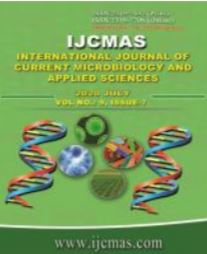


 National Academy of Agricultural Sciences (NAAS)
National Academy of Agricultural Sciences (NAAS)

|
PRINT ISSN : 2319-7692
Online ISSN : 2319-7706 Issues : 12 per year Publisher : Excellent Publishers Email : editorijcmas@gmail.com / submit@ijcmas.com Editor-in-chief: Dr.M.Prakash Index Copernicus ICV 2018: 95.39 NAAS RATING 2020: 5.38 |
Several biotic and abiotic constraints significantly reducing the chickpea area and production over last two decades. Among biotic stresses, fusarium wilt caused by Fusarium oxysporum f. sp. ciceri (Foc) is the major soil-borne fungus affecting chickpea production globally. This Fusarium wilt disease affects chickpea not only quantitatively but also qualitatively. The development of resistant varieties is the most effective method to manage this disease and to stabilizing its productivity. Hence, present investigation was undertaken to evaluate the resistance of 129 chickpea national crossing program (NCP) lines against Fusarium wilt in a wilt sick plot facility made available at zonal agricultural research station (ZARS), Kalaburagi during post-rainy season of 2018, A total of 34 lines recorded low Per cent disease incidence (PDI) rate and thus designated as resistant lines. All the lines were further categorized into moderately resistant (34 lines), moderately susceptible (26 lines), susceptible (29 lines) and highly susceptible (6 lines) based on their PDI records. The resistant lines identified during the study can be further used in developing resistance cultivars directly or can be released as a variety. NCP Fâ‚‚-1(1), NCP Fâ‚‚-1(7), NCP Fâ‚‚-2 (6), NCP Fâ‚‚-2(11), NCP Fâ‚‚-2(12), NCP Fâ‚‚-2(14), NCP Fâ‚‚-3(10), NCP Fâ‚‚- 4(34) with 0.00 PDI could be the best for further use.
 |
 |
 |
 |
 |